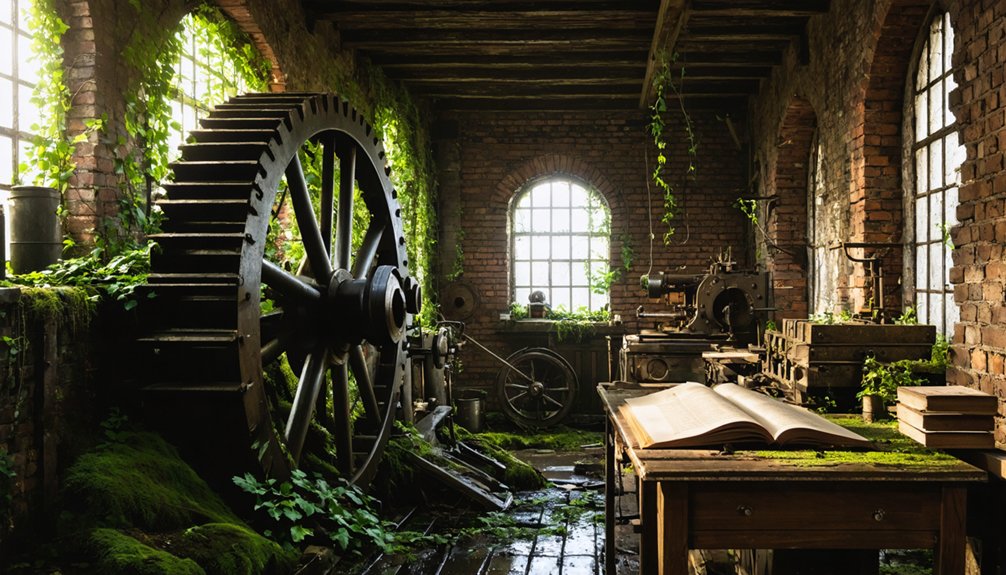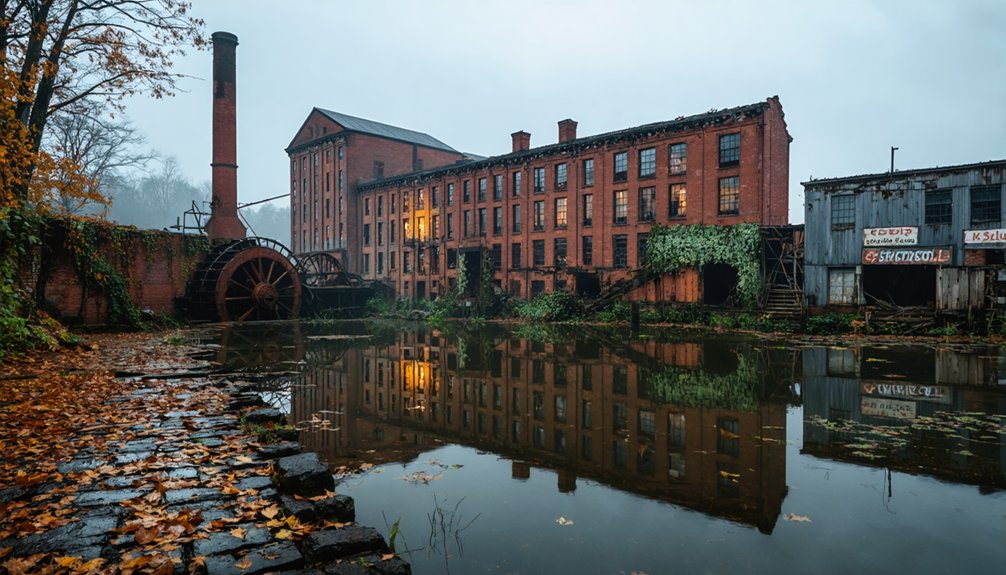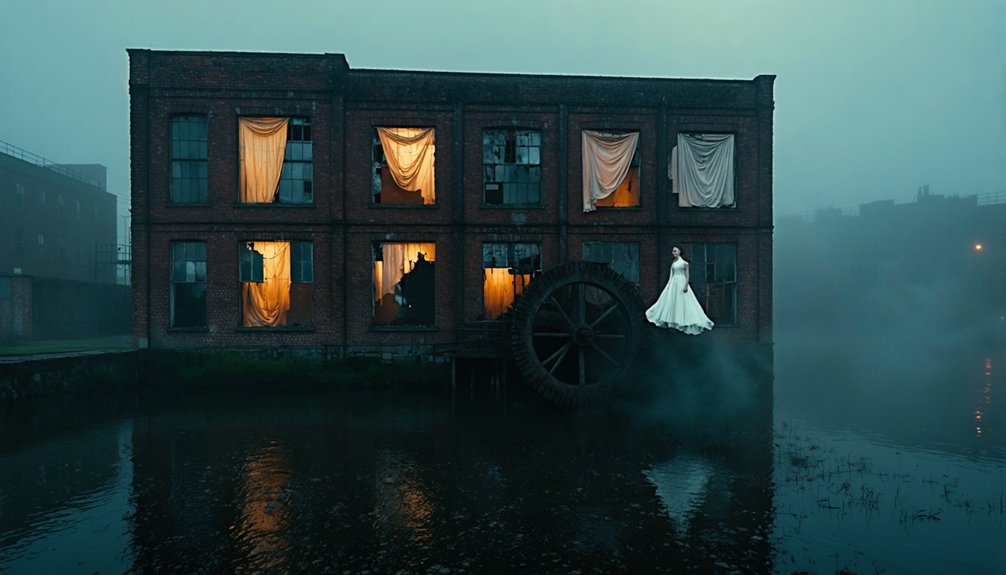When you explore America’s abandoned mill towns, you’ll encounter more than crumbling brick and rusted machinery. These industrial ghosts harbor stories of child laborers, tragic accidents, and the economic heartbreak that silenced once-thriving communities. Former workers’ spirits reportedly appear in period attire, while unexplained footsteps and phantom machinery sounds echo through empty halls. Beyond the eerie legends lies a rich cultural heritage waiting in these weathered landscapes.
Key Takeaways
- Mill town legends often feature apparitions of workers in period attire appearing on abandoned factory floors.
- Unexplained phenomena like phantom machinery sounds and footsteps create persistent ghostly folklore in former industrial communities.
- Tragic industrial accidents underpin many haunting stories, with spirits said to return seeking acknowledgment or justice.
- The eerie beauty of abandoned mills with nature reclaiming spaces provides atmospheric settings for supernatural tales.
- Community-preserved mill sites often become focal points for local ghost stories that connect present generations to industrial heritage.
The Rise and Fall of America’s Mill Town Communities
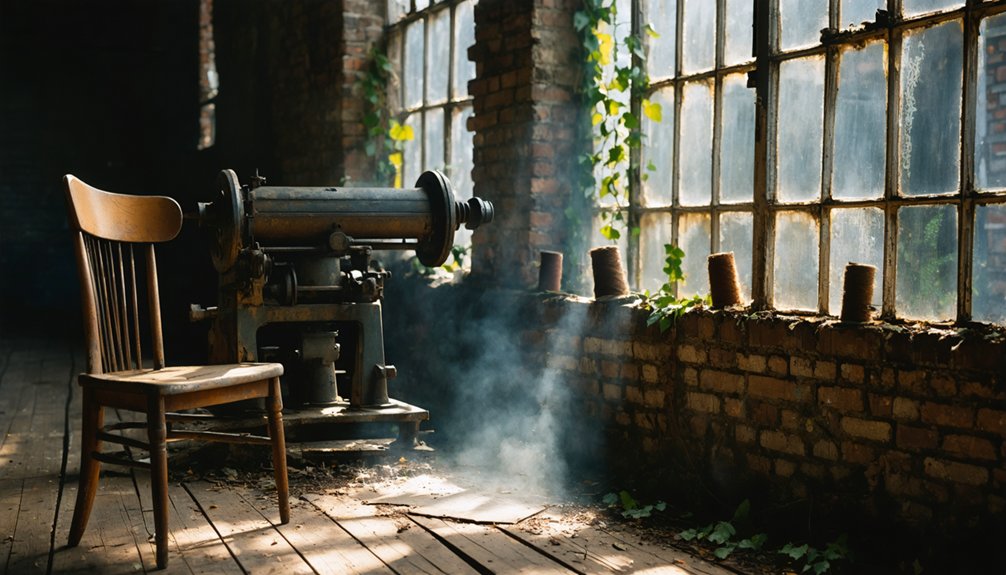
As America’s eastern rivers carved their paths through the landscape, they simultaneously etched the foundation for an industrial revolution that would transform the nation.
You can trace our mill town heritage to the 1700s, when German and Scots-Irish farmers established the first water-powered mills along Maryland’s Jones Falls and Patapsco rivers.
The industrial evolution accelerated dramatically after Samuel Slater introduced his revolutionary spinning technology in Rhode Island around 1790.
Communities like Lowell, Massachusetts emerged as meticulously planned industrial centers, with their brick mills and worker housing representing a new social order.
The Jones Falls river provided exceptional power for mill operations, with its waters dropping 259 feet in just a two-mile stretch.
These purpose-built industrial communities became increasingly common, with the first company town in the Pacific Northwest established at Teekalet in 1853.
Whispers From the Abandoned Factory Floor
If you walk through an abandoned factory floor today, you’ll hear echoes of machinery that once roared with life and workers who shared both hardships and camaraderie during their shifts.
These forgotten spaces, now hazardous with weakened structures and chemical residues, still hold the whispers of thousands who spent their lives creating America’s industrial might. The disorganized floors created high injury risks for workers who navigated these spaces daily. Many of these facilities experienced nearly 9,000 injuries annually from conveyor-related accidents alone.
The abrupt closures left final timecards unpunched and personal belongings in lockers, creating frozen-in-time tableaus that tell stories of workers’ last shifts before mill towns began their economic decline.
Forgotten Factory Voices
The abandoned factory floors of America’s old mill towns still echo with the voices of those who once toiled within their walls, particularly the children whose small hands and nimble fingers became essential tools in the industrial machine.
These forgotten narratives reveal five-year-olds working 16-hour shifts, earning mere fractions of adult wages while facing constant danger.
You can almost hear their whispers when walking through these hollow spaces—stories of burns, crushed limbs, and stolen childhoods.
Child labor wasn’t a choice but a desperate necessity for immigrant families and orphans trapped in poverty’s cruel grip.
Many sacrificed education and innocence to operate dangerous machinery, their small bodies perfect for reaching into tight spaces.
The psychological scars lasted lifetimes, with memories of abuse and exhaustion that followed them long after leaving the factory gates.
Like eleven-year-old Mary at the Cluett Peabody Company, many children endured twelve-hour workdays that left them physically depleted and emotionally broken.
Today’s immigrant teenagers continue this legacy, working overnight shifts in dangerous meatpacking plants while trying to attend high school during the day.
Machinery’s Ghostly Echoes
Rusted giants stand frozen in time throughout America’s abandoned factories, where massive engines and intricate machinery collect dust in industrial graveyards once pulsing with productivity.
When you walk these silent floors, you’ll hear the ghostly machinery in your mind—turret lathes and generators that fell victim to technological evolution. Japanese competitors invested billions in computerized alternatives while these plants stood still, refusing to adapt.
The symphony of silent machinery creates an industrial nostalgia that’s both beautiful and tragic. Entire production lines—from canning equipment to cold storage units—remain intact but decaying, mute witnesses to your town’s economic collapse. Springfield’s Jones and Lamson factory, once the centerpiece of Precision Valley, stood as a prime example of this decline when it closed in 2001. Much like in Namu, where thousands of salmon cases were once processed each season, the abandoned facilities now exist as a time capsule of industrial activity.
Weather and time accelerate the deterioration, transforming what was once cutting-edge technology into haunting sculptures that echo America’s manufacturing past, now frozen between memory and rust.
Workers’ Last Shifts
Wandering through abandoned factory floors after dark, you’ll occasionally hear the unmistakable sounds of a shift change that never arrives—phantom footsteps echoing down empty corridors, mysterious hammering from machinery long disconnected, or whispered names called out in vacant break rooms.
These ghostly sightings aren’t simply town legends; night watchmen frequently report encountering shadowy figures resembling workers frozen in time, particularly near closing hours. Security guards have reported unsettling gut feelings while conducting their rounds through dimly lit warehouse spaces.
Some factories remain eerily preserved, tools laid down mid-task as if employees might return any moment. The abandoned site in Latvia exemplifies this phenomenon, with massive machines that appear ready for immediate operation with just the press of a button.
Factory folklore often stems from real disappearances—workers who vanished during final shifts, leaving behind half-finished projects and personal belongings.
Their presence lingers in unexplained footprints, lingering industrial smells, and lights that operate on schedules nobody set.
You’re experiencing the emotional imprint of labor’s last moments—the unfinished business of our industrial past.
Ghost Stories and Urban Legends of Former Mill Workers
You’ll hear them if you walk the old mill floors at midnight—the whispers of former workers whose tragic deaths have transformed into spectral legends passed through generations.
Their shadows linger near the looms where they once toiled, often appearing suddenly in period-appropriate attire before vanishing into the eerie silence.
These midnight encounters frequently connect to historical injustices, as the spirits of workers killed in poorly documented accidents return to the sites of their demise, seeking acknowledgment or revenge for forgotten industrial tragedies.
Midnight Mill Whispers
As darkness falls across the old mill towns of America’s industrial heartland, the spirits of those who perished within their brick walls seem to stir from their eternal slumber. You might hear the midnight echoes of Thomas, forever trapped in the machinery that claimed his young life, or encounter “Sally” wandering the fourth floor of Brookstown Inn, her tragic fall replaying through eternity.
These spectral laborers appear in tattered work clothes, manifesting near the sites of their demise—elevator shafts, machine rooms, or melt shops where industrial accidents once occurred.
If you’re exploring South Carolina’s State Museum, watch for “Bubba” in his overalls, or feel sudden cold spots where restless spirits gather. Their stories preserve the forgotten struggles of workers whose deaths were often concealed by mill owners, their whispers ensuring industrial sacrifices aren’t lost to time.
Loom Shadows Linger
The skeletal figures of former mill workers continue to haunt the abandoned looms where they once toiled, their ethereal forms most visible during the midnight hours when the moon casts long shadows across rusted machinery.
You’ll find these loom spirits particularly active in room 401, where overnight guests report fitful sleep disruptions and sudden temperature drops.
Mill folklore thrives in these converted spaces where tragedy once struck:
- Apparitions in tattered uniforms vanish into thin air when approached
- Phantom sounds of clanking and moaning echo through corridors
- Misty figures congregate near elevator shafts and dormitory windows
Our community remembers those who perished in machinery-related incidents, their stories preserved not just in historical records but in the spectral manifestations that remind us of industrial-era sacrifices.
When the Machines Went Silent: The Psychology of Deserted Industrial Spaces
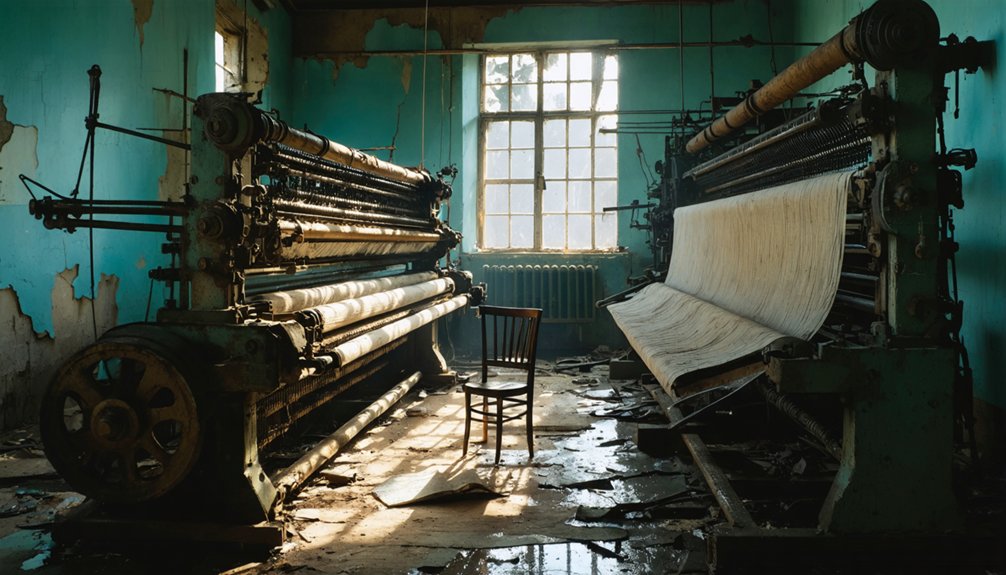
Silence hangs heavy in abandoned mill towns, where once-thundering machines now sit dormant under layers of dust and decay, creating psychological landscapes as complex as the industrial histories they contain.
You’ll feel the contradictory pull of these spaces—fascination mixed with unease as you navigate their emptiness.
The psychological decay extends beyond crumbling walls into community consciousness. Residents living near these industrial ghosts often experience heightened stress, depression, and a sense of powerlessness that seeps into daily life.
Yet these ruins also capture emotional nostalgia, prompting questions about what once was.
When you explore these spaces, you’re participating in a complex psychological exchange—confronting mortality and time’s passage while seeking meaning in the stillness that’s replaced industrial rhythm.
These empty factories remain powerful catalysts for both community trauma and curious reflection.
Preserved in Time: Mill Towns as Historical Haunts
Beyond the eerie stillness of abandoned industrial spaces lies another chapter in mill town stories—places where history hasn’t surrendered to decay but instead stands carefully preserved as living museums.
These industrial heritage sites connect you to America’s manufacturing past while showcasing remarkable community resilience.
When you visit places like Glencoe Mill Village or Rush’s historic district, you’ll find:
- Original structures repurposed as museums, homes, and cultural spaces
- Community-driven preservation efforts, where locals like Silverton’s miners became their own restoration contractors
- Architectural remnants—water towers, canals, and granite buildings—telling stories of industrial ingenuity
At Glencoe, where a children’s museum now occupies a former mill building, you’re walking through living history.
The $625,000 price tag on a restored mill house demonstrates how these historical haunts have transformed from forgotten spaces to treasured landmarks.
Company Towns and Their Lasting Cultural Impact
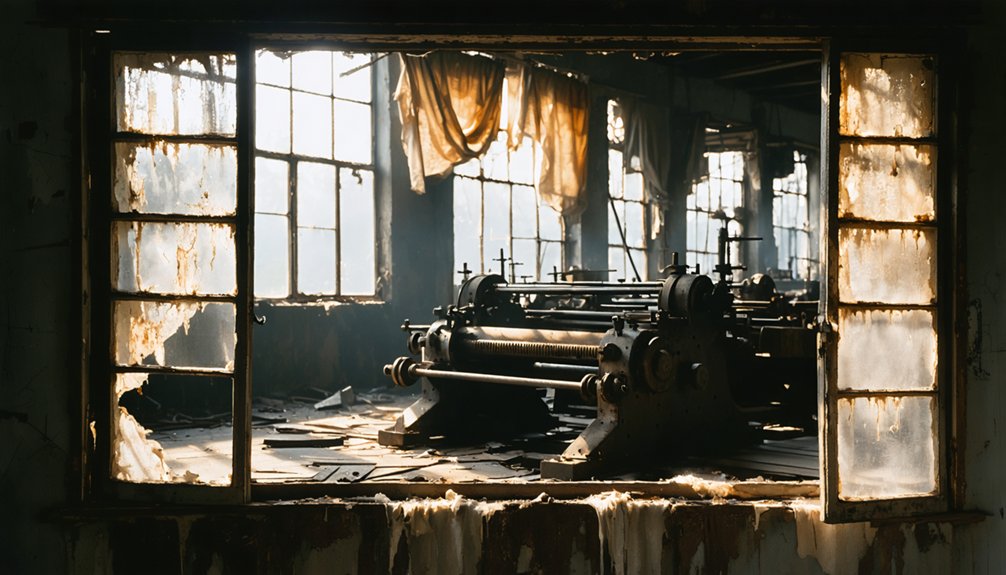
While walking the orderly streets of America’s former company towns, you’ll encounter more than just abandoned buildings—you’re witnessing the physical remnants of a complex social experiment that shaped generations of workers and their families.
These planned communities fostered unique cultural heritage through company-sponsored events, local traditions, and shared workplace experiences. You can still see it in preserved architecture, community gatherings, and the stories residents pass down.
Community identity persists in these towns through architectural footprints and collective memories that outlived the companies themselves.
Despite the controlling nature of single-employer economies—where housing, stores, and even currency belonged to the company—these towns developed remarkable community resilience.
Today’s tech campuses mirror this model, while former mill towns have either transformed into public municipalities or become tourist destinations. Their legacy lives on in ongoing debates about corporate responsibility and in the distinctive local identities that survived long after the company’s influence waned.
Tragic Tales From the Textile Mills
The lives of textile mill workers were often cut tragically short, as evidenced by the staggering tuberculosis mortality rates that claimed nearly half of young workers in the early 1900s.
These textile tragedies weren’t limited to tuberculosis—the notorious “brown lung” disease ravaged respiratory systems, while flax fibers in linen mills literally punctured workers’ lungs.
As you walk through our preserved mill towns today, you’re treading where countless worker struggles unfolded:
- Female workers aged 15-24 faced a 50% death rate from tuberculosis alone
- “Dipping” tobacco snuff, used to combat dust irritation, ironically caused mouth and throat cancers
- Loose fibers created treacherous floor conditions, leading to falls that compounded the daily dangers
While modern mills have dramatically improved safety, these stories deserve remembrance.
Photographing the Eerie Beauty of Mill Town Ruins
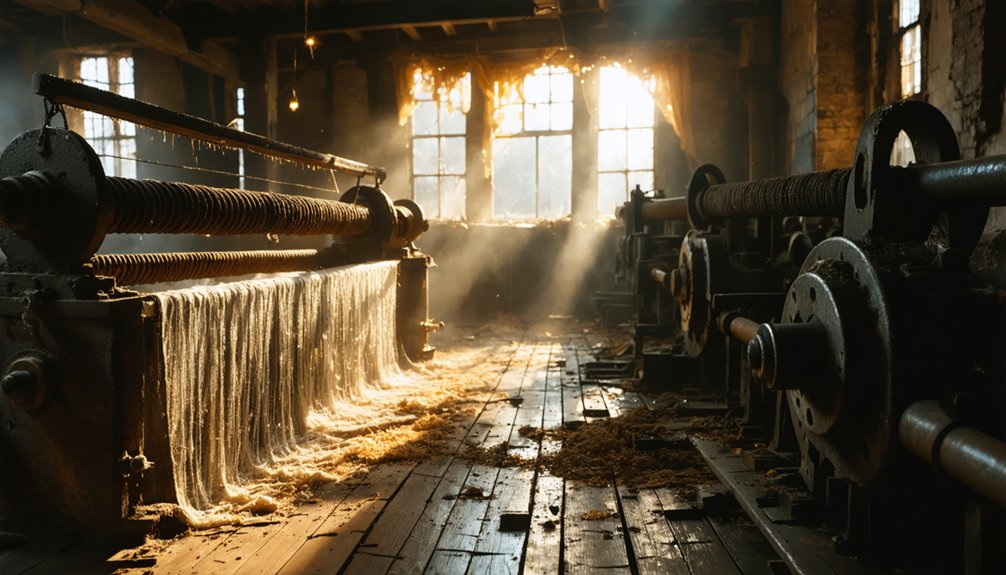
Those tragic mill histories, though devastating to contemplate, have left behind physical remnants that now captivate photographers and historians alike.
The haunting beauty of these industrial ruins has become a magnet for mill photography enthusiasts.
You’ll find these abandoned structures reveal compelling visual stories—massive wooden beams bathed in light filtering through broken skylights, nature steadily reclaiming brick archways, and forgotten machinery standing as silent witnesses to bygone eras.
Sites like Fitchburg’s railway-lined ruins and Connecticut’s Willimantic Thread Mill offer particularly evocative scenes.
Urban exploration photographers should note that many locations display “KEEP OUT” warnings for good reason.
Structural instability, toxic materials, and legal restrictions present real challenges.
For safer options, collections from Wicked Dark Photography and Abandoned Wonders provide inspiration without the risks.
Frequently Asked Questions
How Do Mill Town Hauntings Compare to Other Industrial Ghost Stories?
You’ll find mill town legends share core elements with other industrial hauntings, though they’re uniquely characterized by textile machinery sounds, while mining and factory spirits often reflect more violent, explosive deaths.
Can Paranormal Investigators Legally Access Abandoned Mill Properties?
As darkness blankets these forgotten temples of industry, you’ll need to navigate property rights carefully. You can legally access abandoned mills only with explicit owner permission, honoring investigation ethics that preserve our shared industrial heritage.
Were Mill Town Ghost Stories Used to Discourage Labor Organization?
Yes, you’ll find ghost folklore was strategically leveraged by mill owners to discourage worker solidarity. They amplified supernatural fears during periods of labor unrest, protecting their interests while suppressing your community’s organizing efforts.
Do Former Residents Return to Participate in Ghost Tours?
Less than 5% of ghost tours feature actual former residents. You’ll rarely witness former mill workers sharing tales of spectral encounters firsthand, though their stories of ghostly apparitions live on through descendants and historians.
How Have Digital Archives Preserved Mill Town Supernatural Folklore?
You’ll find digital archives have preserved mill town supernatural folklore through oral history recordings, digitized photographs, and interactive exhibits. Digital preservation techniques now allow folklore analysis that connects you with these liberating ghostly narratives of industrial communities.
References
- https://millmuseum.org/history-2/sweat-of-their-brows/rural-communities/
- https://www.encyclopedia.com/history/dictionaries-thesauruses-pictures-and-press-releases/ghost-towns
- https://en.wikipedia.org/wiki/List_of_ghost_towns_by_country
- https://en.wikipedia.org/wiki/Ghost_town
- https://scholarworks.umass.edu/bitstreams/1eaf620d-a116-4f66-b9ea-40cab10cc6f2/download
- https://socialwelfare.library.vcu.edu/organizations/labor/company-towns-1890s-to-1935/
- https://www.ncpedia.org/anchor/life-mill-villages
- https://www.baltimoreindustrytours.com/history.php
- https://www.historylink.org/File/23208
- https://www.savagemill.com/history/
